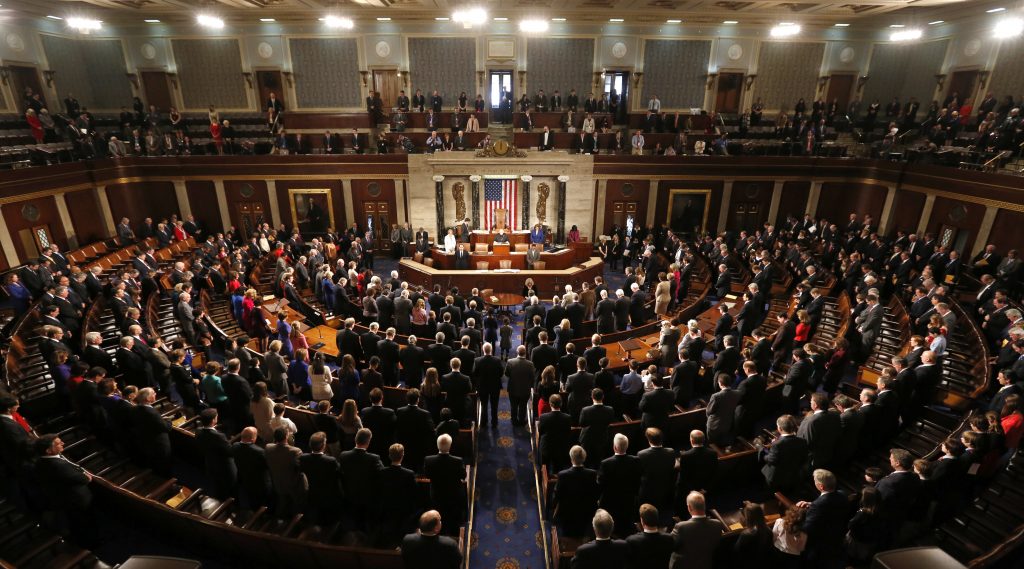
REUTERS/Kevin Lamarque
The best laid schemes of mice and men never met the wrath of the U.S. Congress. With 2018 in full legislative swing, this year promises tight deadlines, fiscal cliffs and legislative brinksmanship. In election years, lawmakers typically avoid writing major legislation, but with the backlog of issues from 2017, the 2018 midterms look to be a spattering of high-profile legislation and campaigning.
In their rush to leave for the holidays, lawmakers passed a short-term spending bill that expires Jan. 19. Trump and GOP leaders will need Democratic support to fund the government and avoid a similar continuing resolution in a month’s time.
2019 budget and appropriations look equally dismal. The president’s FY19 budget proposal is expected in Feb. and will likely resemble last year’s proposal that cut agency funding across the board and increased military spending. One of the main disagreements is whether a DACA (Deferred Action for Childhood Arrivals) fix will be included in the spending package.
Without knowing how much to spend this year, lawmakers cannot finish work on their trillion-dollar omnibus bill to fund the federal government for 2018. Congress has until March to assemble a solution to President Trump’s decision to end the DACA program. Trump ended the program in Sept. 2017 but has also said Congress should write a legislative fix to the program.
There is the semblance of bipartisan support in Congress and in the public to grant the DREAMers legal status and even a path to citizenship, but parties in Congress disagree on whether to include such a fix in the spending bill.
The most recent ruling by a District Court Judge in San Francisco, Jan. 9, will allow the continuation of DACA (excepting new applications) until legal challenges brought in multiple courts are resolved. The administration is expected to appeal the ruling.
Barring action from Congress to raise the nation’s debt limit, the US Treasury will run out of money to pay its bills sometime in spring. Treasury lost its authority to borrow money on Dec. 9 and has been employing “extraordinary measures” – a type of accounting gimmick – since then. Treasury has until late March or early April to borrow more money, according to the Congressional Budget Office.
For the first time since 2008, Congress is working to rewrite the massive bill authorizing higher education in America – the Higher Education Act (HEA). The House version of the bill would have serious implications for how students pay for college and how colleges are evaluated. The bill would rescind regulations on for-profit colleges and steer federal money to apprenticeship and career training programs.
Representative Virginia Foxx, the North Carolina Republican who chairs the House education committee, looks to simplify the federal student aid program (by ending loan repayment benefits), to eliminate the gainful-employment rule and other regulations long opposed by for-profits and to link federal aid eligibility to students’ ability to repay loans.
The bill also eliminates an Obama administration rule designed to thin career education programs that graduate students with debt they can’t repay. Another provision in this HEA adds graduation benchmarks for minority-serving institutions seeking dedicated federal grant funding with colleges across the board liable for student progress on loan repayment.
The full ramifications of the 542-page bill passed by the House committee before holiday break are still unknown. The bill would also affect sexual harassment reporting and disciplinary procedures, free speech on campus and hazing policies. The speed with which the House version went through committee markups and approval left many questions unanswered. The Senate has not unveiled a draft bill of HEA reauthorization and there are many differences left to negotiate as well as a full House vote on the bill.
Duke has a vested interest in the outcome, particularly how the House version would negatively affect graduate education and borrowing. The bill eliminates the in-school subsidy on student loans, reduces the amount parents and graduate and professional students can borrow, devises a complex set of new requirements around institutional risk-sharing and changes important loan forgiveness options for students. Each of these provisions is vitally important to our students and deserves a more thorough discussion and debate than they are currently slated to receive.
On Dec. 22, 2017, the Ninth Circuit Court of Appeals ruled (in Hawaii v. Trump) that President Trump’s most recent Executive Order travel ban exceeded the president’s power under the Immigration and Nationality Act (INA). The INA gives the president power to bar the entry of foreign nationals “detrimental to the interests of the United States.” Employing a “common sense” reading of the INA, the Ninth Circuit rejected a reading of statutory provisions in isolation.
Instead, the Ninth Circuit argued that a court should construe that provision in light of the INA’s language, legislative history and overall scheme. Other key elements of the INA include reliance on consular officers’ knowledge of country conditions, the abolition of national origin quotas in 1965, and Congress’s enactment in that year of a provision barring national origin discrimination in the issuance of immigrant visas.
However, there is still no final verdict on the legality of President Trump’s most recent travel ban. The Supreme Court allowed this third ban to take effect back in early December. The Ninth Circuit released its decision declaring the third travel ban illegal but have put their decision on hold until the Supreme Court can review it this year.
Pushing contentious items up to a higher authority or to a later date is par for the course in the capital this season. Congress is famous for deadline-hopping and serial procrastination, but this spring 2018 will prove especially trying as the federal government, from the court system to congressional appropriators, will rush to write actionable laws to keep the government both funded and functioning.
